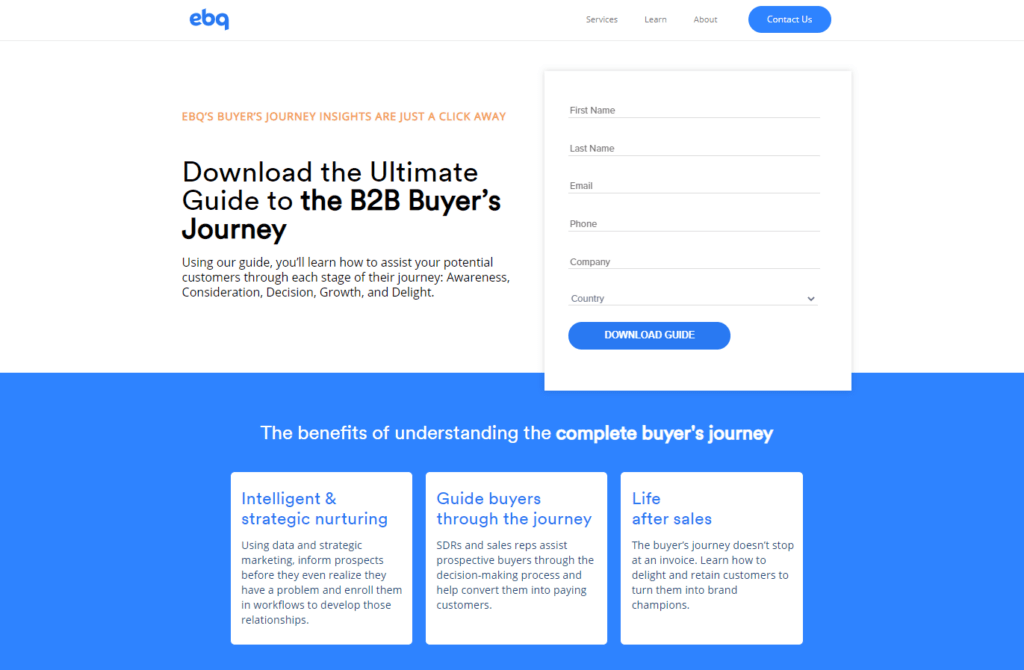A company’s website is important for many reasons; mainly, it serves as a hub to represent everything about the brand. Efforts to get more website traffic, such as keyword bids and SEO, will have little impact if your website doesn’t deliver the proper user experience for your audience.
Ideally, users coming from any traffic sources (such as organic search, social media, and paid ads) will end up on your website and be directed further down the buyer funnel.
Because websites are critical for numerous reasons, we will discuss the variety of ways a website can be optimized in relation to automated marketing efforts.

Paid search & organic search campaigns
For both PPC and organic search campaigns, success is entirely dependent on the target audience’s interactions on your website and how effectively the site is able to guide them to convert.
Therefore, after conducting keyword research and implementing it into marketing campaigns, it’s entirely up to the website to take a prospect who has clicked on the landing page and deliver them the proper experience and persuade them to convert.
The idea of a “proper experience” varies from business to business (and therefore website to website). However, there are a few universal truths that can be employed across the board—landing pages should be:
- Relevant to the ad clicked on
- Clear for the user to navigate through
- Focused on getting the user to convert
Below is an example of a good landing page for this purpose:

This landing page was created with a specific goal in mind. It’s focused on getting the user to learn more and directly convert with a specific purpose—persuading the visitor to submit the form and download a content piece. It’s simplistic with few elements on the page. Therefore, the user is attracted to one thing: the thing they searched for.
On the other hand, landing pages that contain too many different elements and general information are not as effective for search marketing. While this sort of content can be fitting for a home page or informational product page, the extra information is distracting for prospects in a search campaign, where users click on ads with a specific goal in mind.
With automation, you can take this content targeting a step further. Most marketing automation platforms have dynamic content and A/B testing features, which allow you to test out landing pages and copy to determine which versions are most effective for a specific audience.

Download the B2B Guide to Marketing Automation
Don’t have time to read the whole guide right now? Download the PDF version of the guide.
Email platforms & CRMs
The sheer versatility of websites in the realm of marketing automation can be demonstrated by their ability to integrate with email and CRM platforms.
As previously mentioned, the website acts as a hub for anything related to a company’s online presence. Customers and prospects are constantly cycling through websites as they proceed further down the buyer funnel to eventually make a purchase.
Due to this, it’s essential for email platforms and CRM tools to integrate with websites, so companies can curate data and manage prospects effectively.
There are a couple of ways this can be achieved. They both revolve around the actual construction of the website:
- The website is built in a proprietary CMS (content management system) that natively integrates with the CRM and email platform (example: HubSpot).
- The website is built externally with the platform associated with the CRM and email platform (example: WordPress).
Proprietary CMS/CRM Combination
This method is more straightforward, as a lot of the work is handled by the company housing both the CRM and CMS. We will use HubSpot as an example of this.
With websites built in HubSpot CMS, any assets used to collect data (such as forms) will be created with their own modules. There isn’t much flexibility here, nor should the user really want to work outside of this if they also use HubSpot CRM.
Regardless, when users submit data on the website, these modules will automatically generate contacts with the submitted information in the CRM.
From there, emails can be created and sent to these contacts within HubSpot. This is convenient for companies looking to have everything in one place.
External Website Integration
This method is a bit more complex and varies from platform to platform. However, most platforms generally integrate in a similar manner.
For this, we will use Salesforce/Pardot as an example of a CRM/email platform combo, with WordPress as an example of an external CMS. Purely for the purposes of website integration, we will focus on how Pardot integrates with WordPress, since Salesforce integrates with Pardot externally.
1. Tracking Code
Pardot will generate a tracking code for users to put on their website such as this:
This code will need to be inserted in the head tag of each page on the website. This is so Pardot can be given permission to track data on the website. Within WordPress, the header.php file will typically contain the head tag to insert this into.
2. Domain Integration
Next is domain integration, which will need to be handled between the domain registrar and the CRM. Essentially, you will need to configure the DNS (Domain Name System), so a subdomain can be allocated to Pardot and used for assets and pages created on the platform.
In layman’s terms, if the main website is called “domain.com,” the subdomain “go.domain.com” would be the domain for the Pardot pages and uploaded files.
To do this in DNS settings, typically you will need to add an A record and input the name of your subdomain.
3. Data Collection
The last step is to integrate data collection from external websites to Pardot. Generally, forms are created and generated within Pardot. In Pardot, the data fields are mapped to corresponding fields in Salesforce. Afterward, Pardot generates a block of code that will create that same form wherever it’s placed online.
Instead of creating a new form on the website, insert this code in its place. Now, users who fill this form will send data to Pardot, which will sync to Salesforce.
Alternatively, if you prefer custom forms on your website, you can generate form handlers in Pardot to integrate with the custom HTML. Form handlers are essentially Pardot forms that take care of field mapping. Therefore, when integrated with HTML forms, the Pardot field will correspond to the desired input.
The effect is ultimately the same—field data will be sent to Pardot, which will sync with Salesforce.
Putting it all together
Websites can make or break a business in the digital realm. They are the hub to which all marketing channels funnel, in order for prospects to learn and convert.
At the end of the day, proper implementation of marketing automation, design, content, and development come together to provide the ideal user experience, and in turn, expand business to a great degree.


